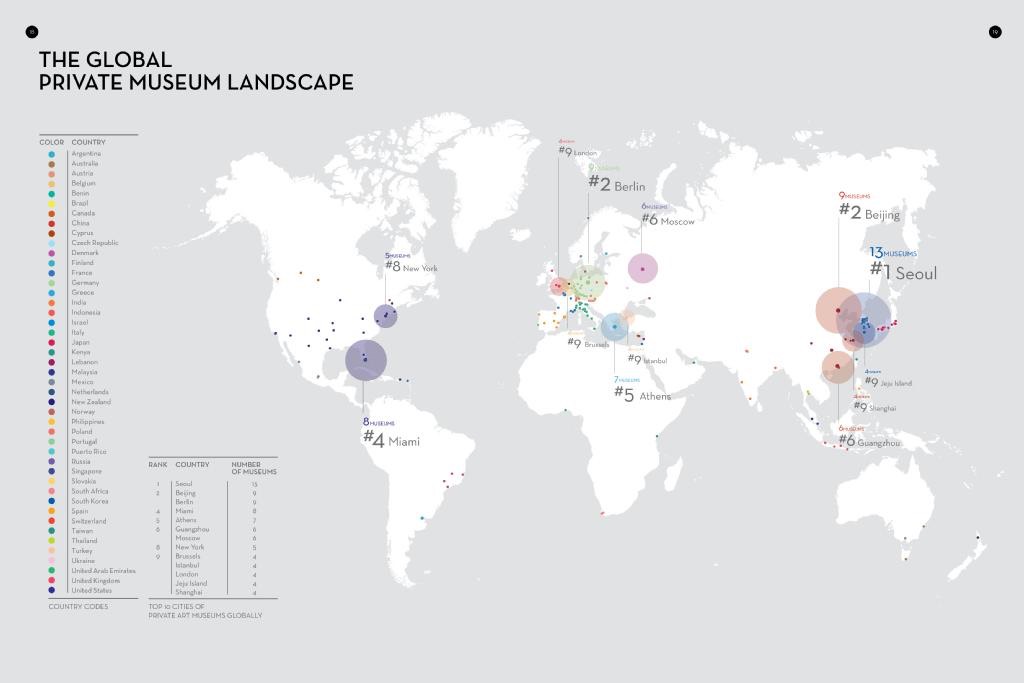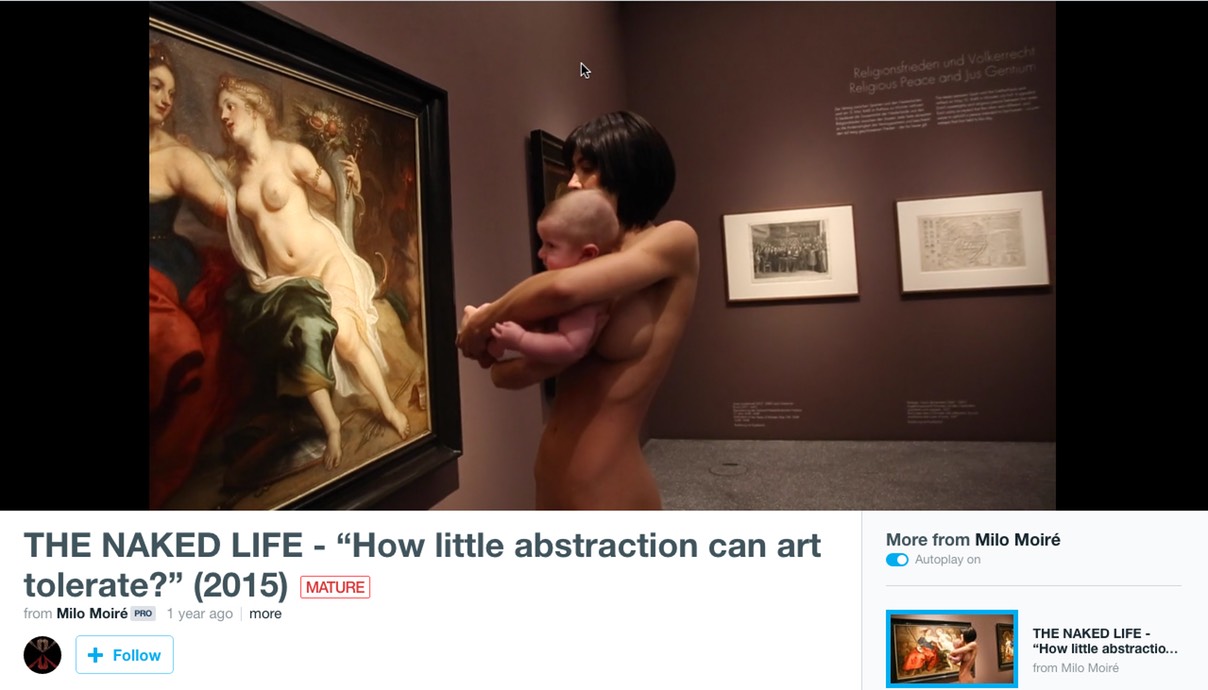NUDE PERFORMANCE IN A MUSEUM BY MILO MOIRÉ
Just found this video of a performance artist taking a stroll through a gallery with a baby.
Site Text says "Milo Moiré, nude, with a nude baby during the closing (2015/02/22) of “The naked life” in the LWL Museum of Art and Culture in Münster (Germany) to celebrate the exhibition. Milo and the baby looked at the nudes in the exhibition and, because of their own nakedness, became a part of it….In keeping with the approach of the artists exhibited, Milo Moiré brings everyday life to art. And yet, she goes one step further in removing herself from the abstract form of representation and shows her main motif of the naked life: A naked infant safe in the arms of a naked woman. This direct confrontation with live nude art challenges others to reflect on familiar forms of perception. How close may a form of representation in art approach real life? Milo Moiré’s performance leaves this question within the realm of the museum: “How little abstraction can art tolerate?” From Bohemianizm.com.
Despite the marxist feminist strategy of the deconstruction of the male gaze, the critical compare and contrast between the high figurative art of historical painting and a contemporary artists video can also be an excercise in temporal and technical shifts in museological framing devices.
Putting gender wars aside for now, one can play the game "whats different about these two art acts", suspending judgement whether this video qualifies.
The common element is the figure, with female eros and reproduction as its theme, similar to the referents in the classical baroque art exhibited. Also appreciated is the lighting of the figures in the paintings is simiar to the museum lighting on the flesh of the female artist and child models.
This gives a convenient scientific method, with the fixing of some terms in the equation of the creation and museumification of art, against the many now variable terms of medium, century, politics, and power relations.
It is worth emphasizing one gender variable, that this contemporary artist is a female using her own body, whereas the paintings artists were typically male, using the female form as referent for generally male viewers. Still perspectival space and naturalism dominate both scenes providing an intimacy.
The video borrows the historicity, social proof and privilege of fine art objects to legalize what would usually be considered an act of institutional sabotage, streaking. The titilation of this feat of legalization may be the underlying interest of this performance, besides the appreciation of a now well documented female form, with its health and reproductive beauty.
Possibly in a few centuries again, the old paintings may finally disappear, and we can view this video of a mother and child in a new art museum. Future patrons may consider the natural status of motherhood, at risk with declining fertility, is as hopeless an act of reproduction as a Baroque oil figure painting in the 21st century. Possibly we could then farm humans in a new, more efficient trans-humanist way. We may then say to ourselves, my gods, what have we done?
Museum artifacts document the slow death of eras.
Private Contemporary Art Museums Using Social
Private Contemporary Art Museums Using Social
95% of private museums use their own website or mailing lists as the primary channel of communication. Social media platforms such as Facebook and Instagram have evidently become popular and are now heavily used in art circles, for nearly 80% of private museums
worldwide are employing these tools. Additionally, 63% of collections also make use
of advertisements via such media as posters.
Read more in the Private Art Museum Report published by Larry's List:https://www.larryslist.com/reports.php

Courtesy of Christoph Noe from Linkedin.
REAL POWER
Rapid cultural evolution may mean there are very few practices with historical relevance left for an artist to directly experience an ancient artistic expression, distanced from their contemporary epoch. It was always an historical simulation, like a proof of a classic equation underpinning pre-Einstein physics, vital but redundant at today's speeds.
Life drawing can be a backstop to the ideological hegemony of the contemporary art critical establishment and its unaffordable educations. Simple drawing, with its mimetic basis, preserves a localized control in the practices of an accessible medium, like chalk on paper. With growing access to the internet and cell phone cameras, there is no reason to decenter the expressions of any human on earth with internet access. We can all post too.
The art establishment, the art museums, and their state supported curatorial practices, with a bloated art market of rare fine art objects, can all now stand aside. A globally accessible medium and methods of dissemination can express the personal artistic cultures of billions, as currently available on Instagram, Youtube, Facebook and Google Plus. We live in a great age of artistic expression, albeit small, simple, and sometimes shy.
In this common global social space, the discourse on life drawing may reside, free of the dominance of contemporary art, the art academy, and identity politics with their enabling institutions.
Life drawing can still use its great historicity, while exploiting the easy, grass roots internet connection to real space, real cultures, and real artistic power in eye and hand.
OBITUARY?
The traditional fine arts are being replaced, slowly disappearing from public view. Drawings are mummified in art museum displays, an obituary of the fine arts. Some university art departments no longer teach life drawing, focusing on contemporary technologies. University tuition is becoming extremely expensive, beyond any measure, and there is only so much room on any BFA curriculum. Students future income security, required to pay that student debt, is ever on assault. Commercialization trumps historicity.
When I was a an art student studying fine arts was affordable, in the 1970's. Our professors callously left the financing of our lives up to us. They had large repeating Canada Council grants, and good for them, but that teaching and grant strategy is no longer feasible. Student loans weren't even available. I worked through school in advertising as a graphic artist, a fascinating allied profession. At that time graphic design wasn't a degreed subject, but a guided studio trade. There was hand lettered headlines, hand retouching of photographs, hot metal type, and hand advertising illustration as a mainstay. All gone.
University tuition was $800 dollars Canadian. Rent and food was cheap. One didn't need a computer in the 1970's. Today tuition is around 10 times that amount. Student rents are now unaffordable, and so is food. A computer and software is thousands.
University is not achievable for a lot of talented students, and especially for Fine Arts students, who are taking a long term employment risk. It is time to rethink the rationale of fine arts in a degreed institution. The encumbrance of student debt is becoming predatory. Installing interior design and graphics degrees is going to help, but isn't a career that can pay the huge university bill. University as a philosophical institution was once only for the very lucky few, or the monastic. The universities democratization was a great feat that may have overreached.
The repetition of historical european artistic practices can bring post-colonial critiques from an ever increasing authoritarian left. I'm not against any critique, but the lack of civility can lead to a censure of expression, creating speech free zones on college campuses. Art can't exist in a speech free zone, unless its art propaganda.
The idea that life drawing gives an artist a visual memory from a figural subject, is debunked as a corrupt class, race or gender power relationship. Figure drawing practices still inform cartooning and fashion design, or are romanticized as soft focus naturalistic visions in academic sepia tones as a kind of laborious illustration for hire. I can't imagine much is really observed or learned, as the studio becomes factory becomes office. Those student debts must really need servicing.
Fine Art was the pinnacle of a hand craft and guild based society. The individual artists vision was a moral goal in the enlightenment, the product of this vision put on display in treasure palaces for all citizens of the republic to admire. As the means of capitalist production has shifted from hand to machine and to computer guided machine, the valuation of the intellectual labour required is now unnecessary. The technological genius behind the hand axe, the greek statue, the oil painting and the life drawing, are finally supplanted by the minor finger manipulation of information on a graphical user interface, or GUI. Press A to level up. Hardware and software enables, conforms, amplifies and then automates the mind.
LIFE DRAWING vs NUDE PHOTOGRAPHY
Comparing life drawing to nude photography shows overlaps and contrasts. A major difference is the cultural privileging of drawing, painting and sculpture in the expression of an artists subjectivity from the point of view of the art public and art historical institutions. A collection of figure drawing can span from cave art to the present, with 40,000 years of temporality.
Photography is a new medium, and although it has replaced the functionality of art, the historicity of drawing and painting remains. This does not deny the potency of photography's own modern history as an art medium, the revolutionary impact of imaging technology, the visual technical interface, information networks, and computer processing on contemporary cultural expression of the figure going foreword.
Due to its success, photography's historicity is guaranteed in time. Problematically, the technology of photography quicly evolves until its product is so removed from it's roots, it is no longer in the same practice. Currently photography is being democratized by the widespread use of accessible high quality smartphone cameras and social media, such as Instagram, on servers and fibre bandwidths with large capacities. The necessity of a fine art practice comes into question, with a global flood of images. Google images makes travel photography almost unnecessary.
Privileging one image over many others has little meaning if every image survives indefinitely in a virtual cloud server backup, retrieved in a moment with #tagging and Google search engines on one’s mobile device over coffee.
The traditional museums highlighting function is now disabled. Why build an expensive civic buiiding to privalege a select few artefacts, when the world outside the msueums stillness flows on.
Miss Elizabeth looks up at Mr. Darcy’s noble marble bust, brightened by the heavenly skylight above. In awe, her frustrated hypergamy tingles, thinking of the easy riches such privilege brings. No such tingle is possible when such artefacts are commonly avaiable.
HAVING DRAWING
Life drawing, intimate and immediate, is still practiced by many artists worldwide. Life drawing can be both private and social, employing a model and generally practiced in a secured studio. Being an exclusive social activity, life drawing has attracted attention from social theorists seeking to establish ideological beachheads. Despite frequent public controversy, the classical practices of life drawing have endured since the renaissance.
When cultivated, the practice of drawing a model develops a visual input with the outside world. This physical connection with the visual world may be why life drawing exists today, after the replacement of many classical art forms with the machine arts of photography and manufacturing.
In critical terms, this connection with the visual world is recognized by art critics and art historian's as an artist "having drawing", the minimum qualification to artistic success in traditional artistic practices. The exhibition of life drawing displays this connection, the relation of the human apparatus of vision to the artists drawing body. The identity relations between all the actors in the drawing practice complicate and enrich the experience.
The effects of the artist's knowledges, cognitions and ideologies on the figural input is shown bare. The reaction of other artists, the publics, and the critical art establishment is often a demonstration of the old expression, "art is a mirror".
